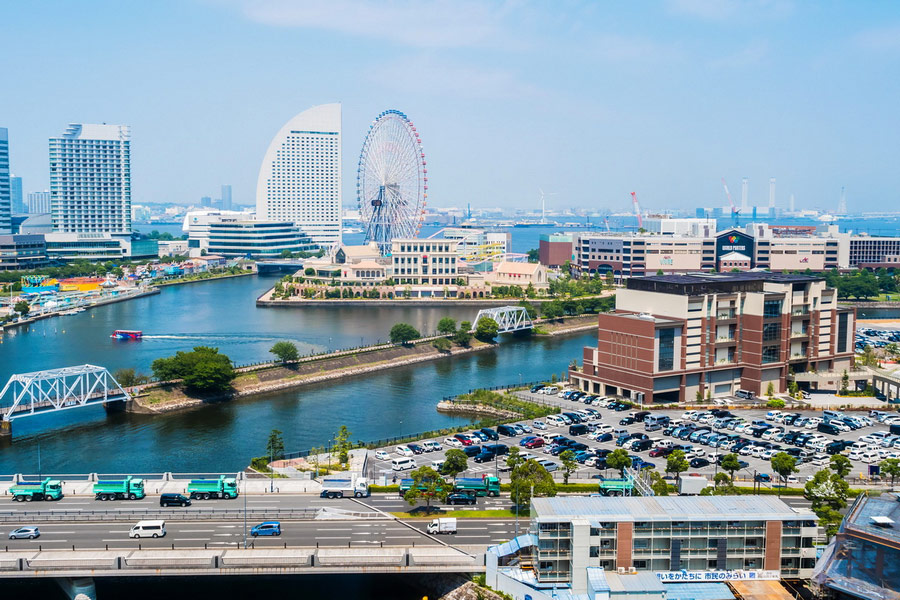Tours, Attractions and Things to Do in Yokohama
Yokohama Travel Guide
Known for Mount Fuji, cherry blossoms, anime, and sushi, Japan has always enjoyed its moment in the spotlight. While the capital, Tokyo, receives the lion’s share of attention, the country’s second city, Yokohama, has emerged from the capital's shadow. It has become a destination with attractions, each as worthy of a visit as the next. This vibrant seaside metropolis is home to over 3.7 million people and attracts visitors from Japan and beyond. Travelers are captivated by its Chinatown, Western-style buildings on the main street of Yamate, beautiful views of the harbor, an international culinary repertoire that whets the appetite, and the Motomachi neighborhood, as well as its cool museums, including the famed Cup Noodles Museum. If you are ready to savor Yokohama’s splendors, our Yokohama Travel Guide covers everything not to miss during your visit to Japan’s coastal city.
History of Yokohama
In 1859, after 250 years of self-imposed isolation of Japan from the outside world, Yokohama Port became the first to accept foreign ships. Consequently, the fishing village of about 100 people developed into a growing center of sea trade, gradually giving birth to several neighborhoods where foreigners lived. Yokohama is referred to as "a city of firsts" as many Western novelties, such as electric lighting, railways, and telephone connections, appeared in Yokohama.
Although the 1923 earthquake and WWII bombardment destroyed much of the city, today Yokohama is a large economic, commercial, and passenger port hub in Japan.
Yokohama has been a pioneering city in Japan, leading the country in introducing numerous Western innovations and establishing important cultural and economic milestones:
| 1853 – Perry’s arrival The American fleet led by Commodore Matthew Perry arrives south of Yokohama and demands that the Edo Shogunate open the country. |
1854 – Treaty of Peace and Amity The Tokugawa shogunate concedes by signing the Treaty of Peace and Amity. |
| 1859 – Yokohama Port Opening On June 2, 1859, treaties are signed with the US, the Netherlands, Russia, Great Britain, and France. |
1860 – The first hotel Yokohama Hotel is believed to be the first Western-style hotel in Japan (it burned down in 1866). |
| 1862 – The first European-style horse racing | 1863 – The first Japanese milk processing and retail business in Yokohama |
| 1865 – First ice cream and beer in Japan was produced in Yokohama |
1870 – Japan’s first daily newspaper, "Daily News." |
| 1869 – Japan’s first telegraph service It was opened at the Yokohama Lighthouse Government Office and Yokohama Courthouse |
1872 – The first railway that connects Yokohama to Shinagawa and Shinshabashi in Tokyo |
| 1872 – First gas-powered street lamps | 1873 – The first soap factory in Japan – Yokohama Isoemon Tsutsumi, after learning soap processing from a French engineer, opened the first soap factory in Japan, located in Yokohama. |
| 1876 – The first tennis court in Japan was introduced in Yokohama It’s believed that the first tennis tournament in Japan was held in Yokohama |
1887 - Japan’s first modern water supply was born in Yokohama |
Landmarks and Attractions in Yokohama
The downtown area in Yokohama is small, and the fascinating landmarks are close to each other, so walking is the best option to see the city. You can take in the lively atmosphere and find hidden treasures along the way. So, put on your walking shoes and get ready for a fun time exploring this city!
Yamate Area
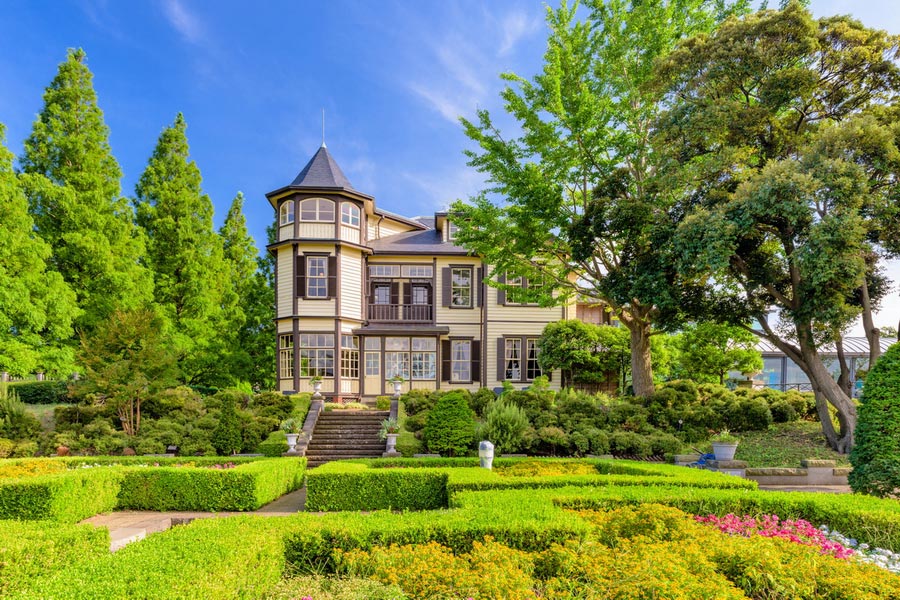
Don't miss out on the awesome Western-style buildings from the 1800s in the Yamate district, overlooking the city. The district is renowned for its striking houses, tall church spires, and entrancing tea and coffee shops. There's only one wooden building left from that time, housing two eateries: a casual cafe on the first floor and a fancy French restaurant, along with the Yamate Museum, on the second floor. And behind the museum, you'll find the Anglican Christ Church, built in 1862 and later rebuilt in 1947.
Motomachi Neighborhood
Motomachi Street, between Chinatown and Yamate, was once a luxurious must-visit shopping destination before World War II, where foreigners lived. Today, it has transformed into a vibrant shopping district spanning five blocks, with many cafes, stores, boutiques, bars, and restaurants. On holidays and Sundays, the street transforms into a pedestrian zone and becomes bustling with crowds, creating a lively and vibrant atmosphere.
East of Motomachi, a densely forested cape marks the entrance to Harbor View Hill Park. All trails in the park lead to the observation deck. Back in the day, it was home to French and English expats. The panorama of the waterfront and Bay Bridge from the top is breathtaking, especially after the sun goes down. And if you keep strolling deeper into the park, you will reach the Foreign General Cemetery. It is the burial site for over 4,500 people from more than 40 countries.
Yokohama Chinatown

Founded in 1859, the Yokohama Chinatown is the biggest Chinese neighborhood in Japan, with around 500 shops and restaurants. Walking along the street, you will encounter stalls selling healing herbs, kitchenware, groceries, and jewelry. It's an ideal spot for trying Chinese fast food, such as Dim Sum dumplings or enjoying a full dinner at one of the top-notch Chinese restaurants.
Kanteibyo, or Kuan Ti Miao, is a temple that enshrines the warrior Guan Yu, highly revered by the Chinese people. The gate's intricate design and the images of dragons make it an impressive sight. Longhaired Guan Yu, the guardian deity of Chinatown, is throned inside, overlooking visitors praying for health and prosperity.
The best time to visit Kanteibyo is Chinese New Year and October 1 (China’s National Day). A shopping complex, Yokohama Daisekai, is near the temple.
Sankeien Garden
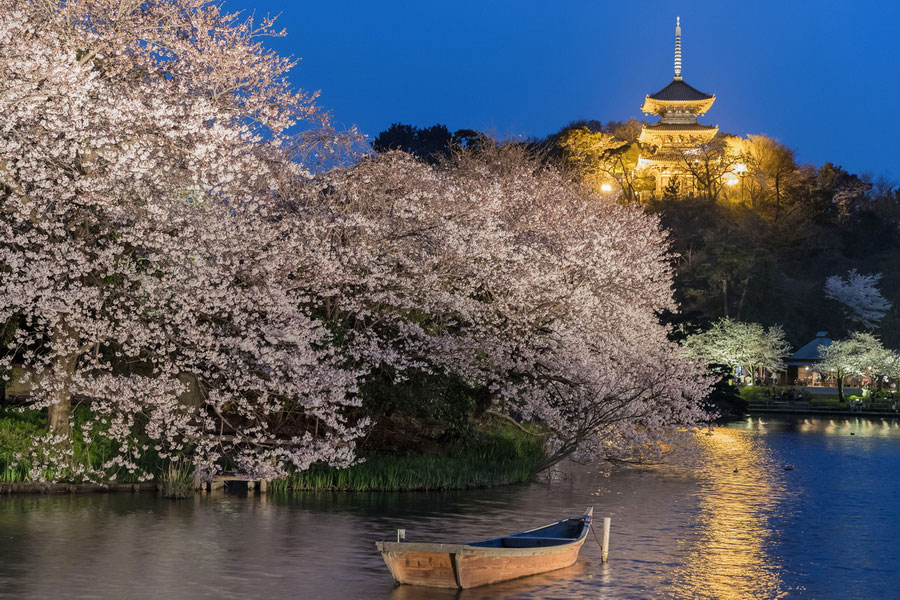
The late 19th-century tale of Sankeien Garden begins with Tomitaro Hara, a rich silk trader, settling on Yokohama's southern slopes. He brought some graceful buildings from Kamakura and the Kansai area to make his spot even better. Today, the park is divided into two sections: the inner and outer gardens. The inner part is smaller and has some historic buildings, like the Rinsunkaku mansion, the only one of its kind left and built by a shogun near the lake back in 1649. The Choshukaku building, dating back to 1623 and situated by a stream, was originally used for tea ceremonies on Kyoto's Nijo grounds. And there's this small temple called Tenju-in with amazing wood carvings.
Nestled amidst the bamboo and plum groves of the outer park, you'll find farmers' houses with straw roofs and a 500-year pagoda perfectly blending into the landscape. The most prominent structure here is the Former Yanohara House. This house stands out for its gassho-style roof, a traditional Japanese architectural style resembling “praying hands.” The entire building was put together without a single nail!
Minato Mirai 21 and Its Landmarks
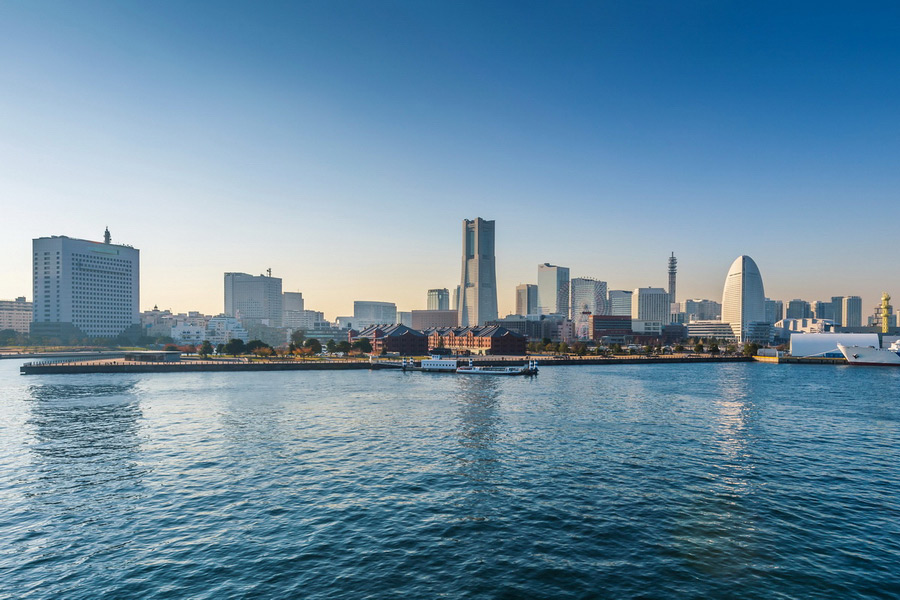
Minato Mirai 21, or MM21, is a modern urban development, virtually a small town with residential buildings, business offices, and cultural institutions. The tourism and entertainment infrastructure has been thriving here since the 1980s. MM 21 caters to many attractions and an unlimited amount of things to do. Check out some of the emblematic sites and activities in Minato.
Kirin Beer Yokohama Factory
The Kirin Beer Yokohama Factory is not far from the city center. Visit the factory to learn about the history of the Kirin brand and witness the intricate beer production process. Moreover, the brewery tour allows guests to sample several Kirin beer varieties.
Yokohama Landmark Tower
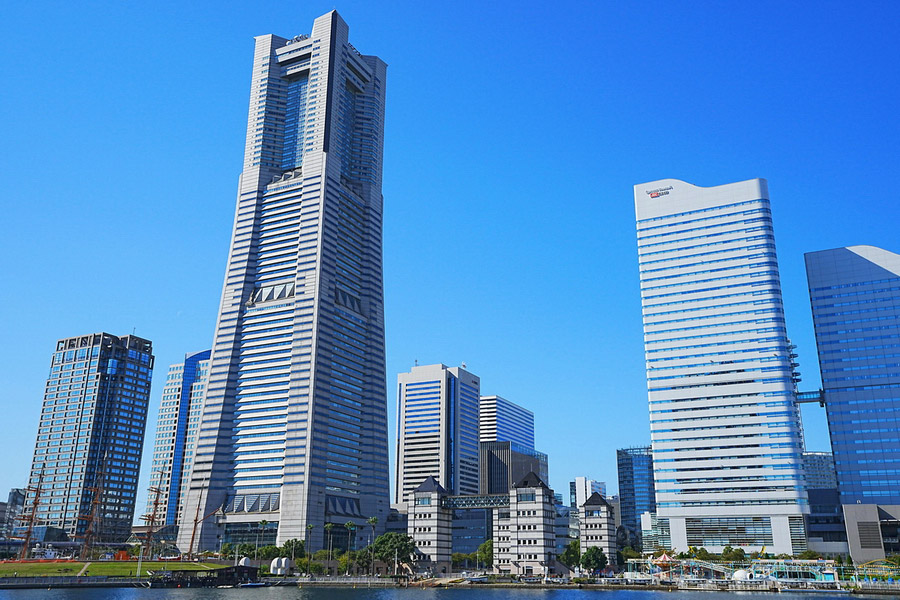
The Landmark Tower is 296 meters high. Its elevators are among the fastest in the world. They can take you to the 69th floor and the Tower Sky Garden in 40 seconds. The garden boasts a 360-degree city view, including Tokyo and even Mt. Fuji on a clear day.
After you leave the Landmark Tower Sky Garden, the elevator will take you to the Landmark Plaza, a shopping center around the five-story atrium. There are many high-end and medium stores, restaurants, coffee shops, and bakeries.
Yokohama Port Museum and Nippon Maru Ship
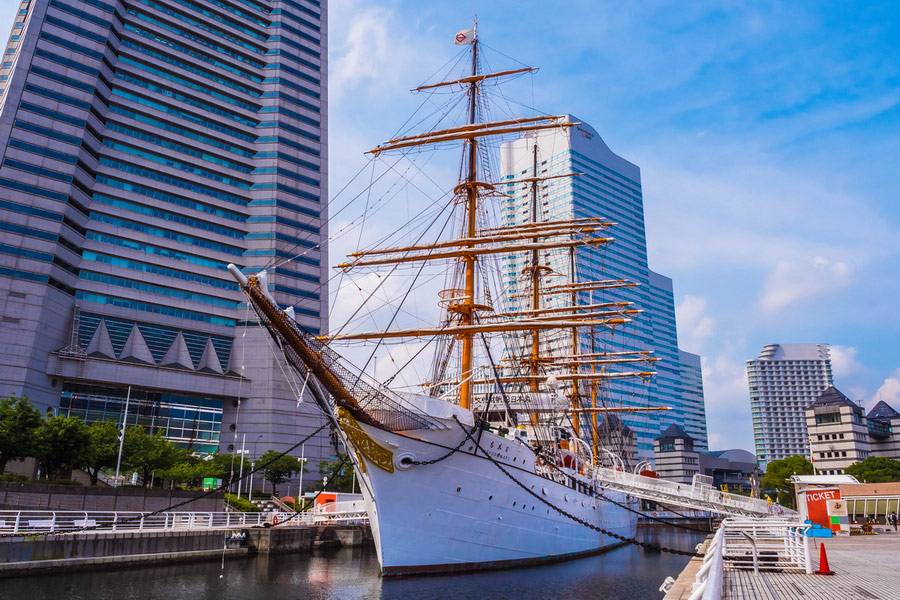
The Yokohama Port Museum is a minute's walk from the Landmark Tower. The highlight of the museum is the Nippon Maru ship, built in 1930 and utilized until 1984. During WWII, the ship served as a sailing hospital.
Guests can access the ship both inside and outside, with displays featuring English inscriptions and an audio guide available in English as well. To visit both facilities, you need to purchase a combo ticket. The museum covers not only the history of shipbuilding in Yokohama but also features many exhibitions dedicated to the modern port and the technical aspects of sailing.
The yacht-shaped Intercontinental Yokohama Grand, easily accessible from the Landmark Tower, is framed by the towering trio of buildings at Queen's Square.
Yokohama Cosmo World and Cosmo Clock 21
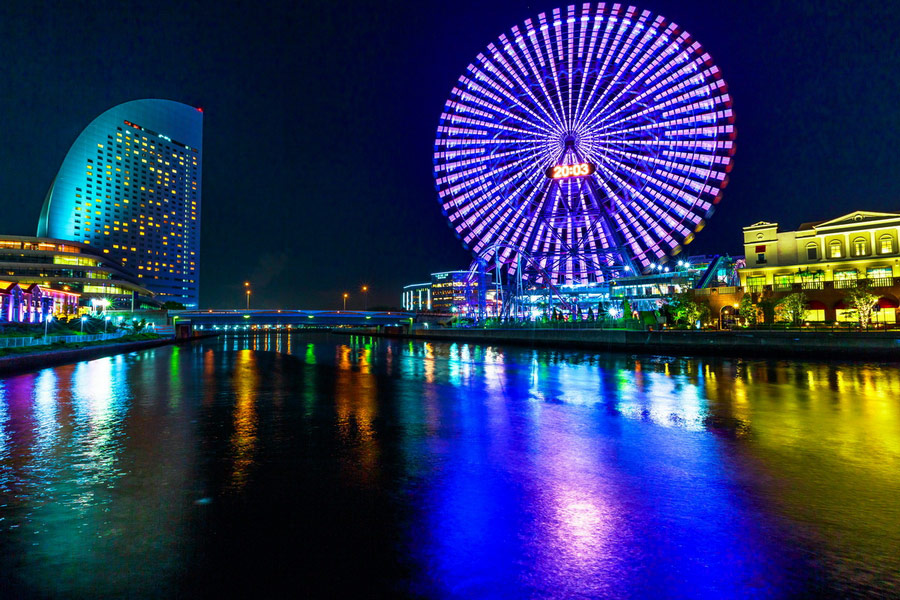
Yokohama Cosmo World is an iconic amusement park in the city. It’s a must-visit for the views and staying until dark to see all the lights. The park features Cosmo Clock 21, a 112-meter Ferris wheel that can accommodate 480 passengers at a time for a 15-minute ride.
Cup Noodles Museum Yokohama
Visitors will have a great time making their own noodles and exploring the Cup Noodles Museum Yokohama. The exhibits and interactive workshop are very entertaining. You can craft your noodle cup and choose ingredients. The museum also presents a short video detailing cup noodle production and its history. It's a must-see for those looking for something fun to do, just a two-minute walk from Cosmo World.
Yamashita Park
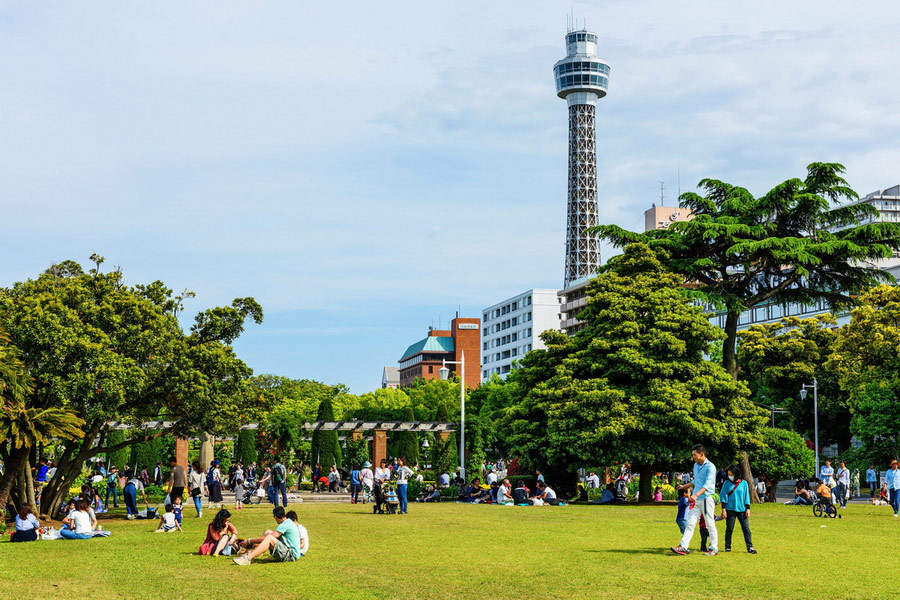
Continuing along the port, you will come upon the 106-meter Marine Tower, which features an observation deck. Just in front of the tower lies the famous Yamashita Park. It’s an ideal spot to relax and enjoy the beautiful flowers, as well as views of the bay and passing ships.
Museums in Yokohama
Yokohama Doll Museum
Just a stone's throw from Yamashita Park or the Marine Tower, you will find the Yokohama Doll Museum. It features diverse exhibits of international and Japanese dolls. Foreign visitors should note that the museum has limited information in English. However, it is still worth visiting for its fabulous collection of classical and folk dolls, including Hina dolls often displayed during the annual Festival of Girls on March 3.
Yokohama Museum of Art
The Yokohama Museum of Art, one of the principal museums of MM21, houses an amazing collection of 20th-century Japanese works, perfectly complementing the grey and chilled space designed by the famous Japanese architect Kenzo Tange. The museum's architecture, especially the central atrium, is particularly striking. Additionally, the museum's library contains many books about world architecture.
Mitsubishi Minatomirai Industrial Museum
A few hundred meters walk from the Yokohama Museum of Art, this museum will spark children’s interest. Several themed sections illustrate Japanese technologies, from modern generators and oil rigs with deep well drilling to futuristic space cities. The technical exhibitions include various models, interactive displays, a flight simulator, and underwater submersible exhibits.
Yokohama Silk Museum
In the late 19th century, Yokohama's rapid growth was largely driven by silk exports. At the Yokohama Silk Museum, you can learn about silk extraction from silkworms and the Japanese silk industry and trade. The museum features a sewing machine where you can try spinning your own silk. A display of luxury kimonos from the Edo period is a highlight. The museum is located across the road from Yamashita Park.
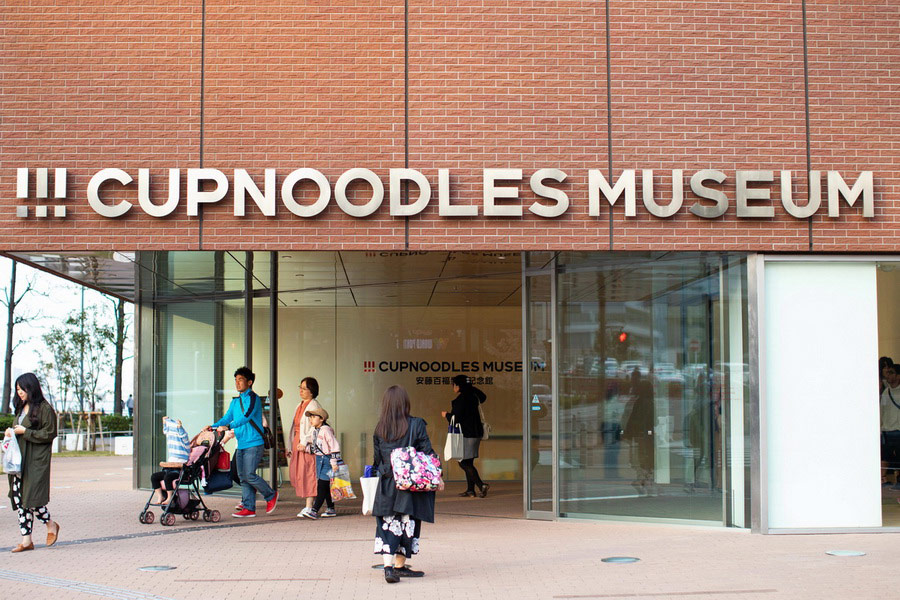
Yokohama Archives of History Museum
A little further along, you will see the Yokohama Archives of History Museum, one of the city's best historical museums, featuring English labels. It details Yokohama's opening to the world after the 1850s through a unique collection of photographs, documents, and relics from that era.
Yokohama Customs Building
You can easily recognize the Yokohama Customs Building, nicknamed 'the Queen' due to its distinctive dome-shaped tower, just across from the Red Brick Warehouse area as you exit Zou-no-Hana Park. Constructed in 1934, it was the tallest structure in Yokohama at the time. A small museum on the ground floor details the history of Yokohama Port and customs.
Yokohama Port Opening Memorial Hall
Nicknamed “Jack,” the Yokohama Port Opening Hall is notable for its classic-style architecture. Opened in 1917 to commemorate the 50th anniversary of the opening of Yokohama Port in 1867, its popular 36-meter clock tower, beautifully lit in the evening, has become one of Yokohama’s symbols.
The Kanagawa Prefectural Museum of Cultural History
Originally the Kanagawa Specie Bank, built in 1904, this historic brick building in Yokohama depicts Kanagawa’s history from ancient times to the present across its five floors.
Entertainment, Parks, and Shopping
While the attractions listed above are must-sees, Yokohama has more to offer, especially if you plan to spend more than a couple of days in the city. There are tranquil temples, lively neighborhoods, and various activities for everyone in Yokohama. Don't be afraid to venture off the beaten path and explore the city's hidden gems.
Entertainment in Yokohama
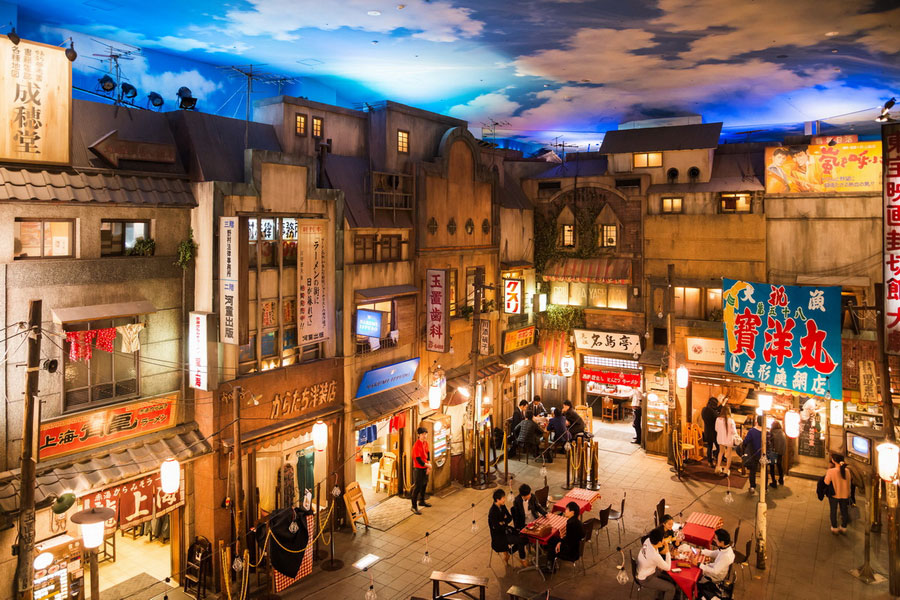
One of the most visited tourist destinations in Yokohama, the Osanbashi Yokohama International Passenger Terminal boasts top-tier views of the bay and is a great starting point for traveling around the city.
Those interested in wildlife should head to the Yokohama Zoo "Zoorasia". Covering a vast area divided into 8 zones, this zoological garden is home to around 100 species of animals from around the world. You can also take a cruise on Yokohama Bay, which offers panoramic views of the city's skyline and landmarks.
Another destination for families is the Nogeyama Zoo, which hosts many animals, including penguins, giraffes, and elephants.
The NYK Hikawamaru Exhibits at Yamashita Park are a treat for history buffs. You can discover the glory days of the ocean liner that once hosted Japanese emperors and Charlie Chaplin, and explore every nook and cranny of the ship.
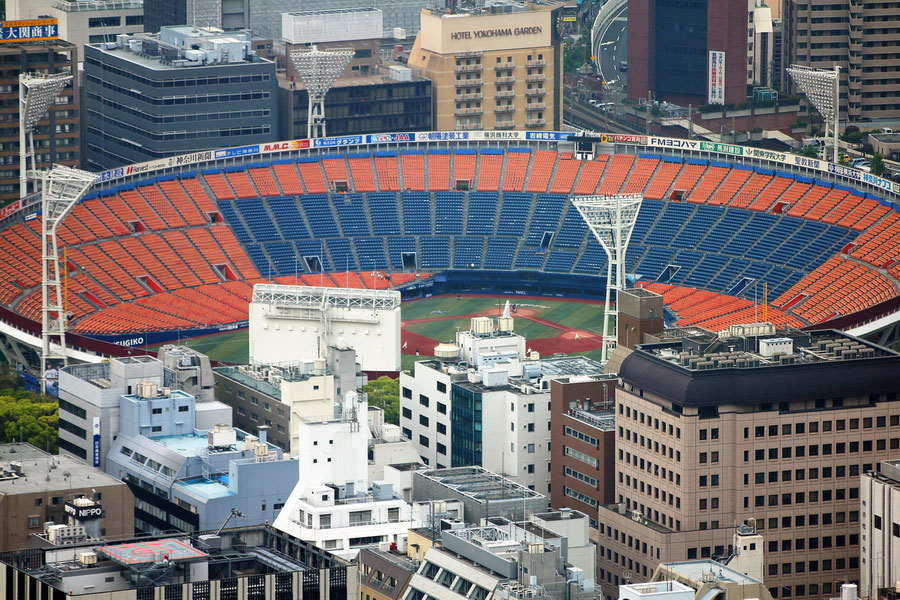
And if you need a little spiritual pick-me-up, swing by the Soji-ji Temple.
The Shinyokohama Ramen Museum is a must-visit for ramen lovers. Here, you can learn about the history of ramen and then head to the basement area, which features many ramen shops, including options for vegetarian ramen.
Yokohama Stadium is where sports enthusiasts can catch a baseball game.
The iconic Yokohama Bay Bridge is a must-see for any tourist, and if you're into science and tech, then be sure to visit the Yokohama Science Center.
Families with kids might consider spending time at the Nagoyama Zoo or the Yokohama Anpanman Children's Museum, based on the popular Japanese cartoon character.
You might add the Yokohama Trolley Museum to your itinerary, which displays original trolley cars used in Yokohama more than 50 years ago. For a peaceful escape, visit the Iseyama Kotai Shrine, overlooking the ocean and the beachfront of the city.
Lastly, don't forget to explore the Yokohama Hakkeijima Sea Paradise, a park with sea creatures in the Aqua sections, and amusement rides in Pleasure Land.
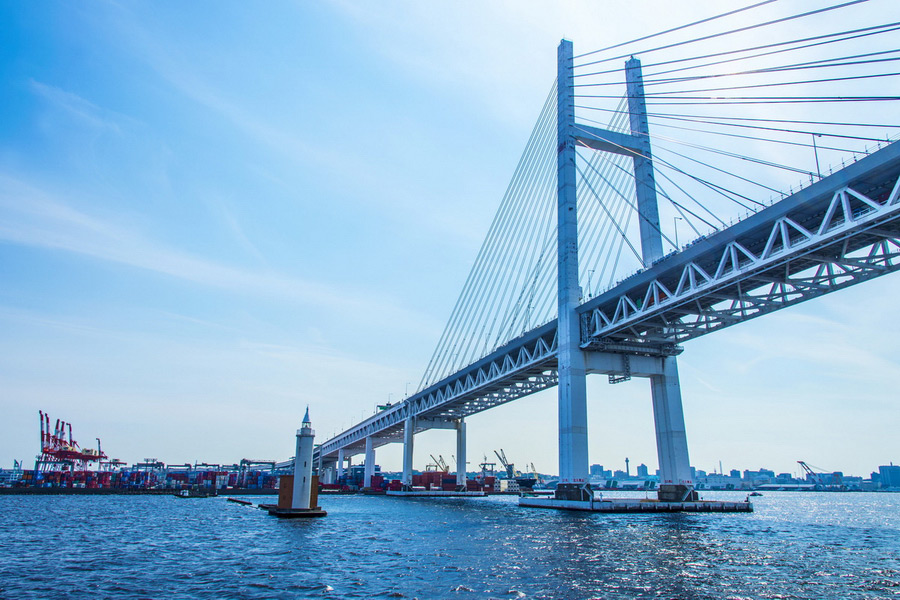
Yokohama Parks and Gardens
We’ve already mentioned Yamashita Park, Harbor View Park, and Sankeien Garden. These are top green areas when it comes to Yokohama parks and gardens. However, there are more nature highlights to stroll around and enjoy a picnic.
Negishi Forest Park
This spacious park covers 1800 hectares. Before it became a park as we know it today, it was first built as a horse racing track in 1867 and then reconstructed into a golf resort after the Second World War. In 1977, the Yokohama officials opened it as Negishi Forest Park. The location is perfect for cherry blossoms.
Rinko Park
Like Yamashita Park, Rinko Park is situated along the seashore of Yokohama. It’s another green space to unwind and admire jaw-dropping views of the bay and high-rise buildings.
Marine Park
Umi-no-Koen or Marine Park can be easily reached by the seaside line. If you are visiting Japan in the summer, you will want to go to this park because it is the only beach in Yokohama that allows swimming. Besides, you can play outdoor games like rugby or soccer and rent barbecue equipment.
Mitsuike Park
This park has everything: picnic spots, playgrounds, a hiking trail, tennis courts, soccer fields, clean toilets, and a lovely Korean Garden. Therefore, Mitsuike Park is highly recommended for families. Kids will love watching ducks and feeding fish in a large pond. There are plenty of mobile food stalls and vending machines. Of course, the best time to visit the park is the Sakura and autumn foliage seasons.
Children’s Country
Kodomo-no-Kuni, or Children's Country, is a massive park that spans over a hundred hectares. It's a true wonderland for kids, but adults can have a blast too. There's a farm, a huge 110-meter slide, a tiny steam train, a pool open in July and August, an artificial river, sports fields, a site for BBQs, and a pond where you can go boating. Fun fact: the park was first opened on May 5, 1965, Children's Day in Japan. It was built to celebrate the royal wedding of Prince Akihito and Princess Michiko, who later became the Emperor and Empress of Japan.
Shomyoji Temple Gardens
The Shomyoji Temple, built in 1258 by the Hojo clan, is one of the oldest temples in Yokohama and a serene spot to relax amidst its stunning gardens. They're especially picturesque during hanami when the cherry blossoms hit full bloom and in autumn when the leaves turn colorful. The temple’s hallmarks are a pond and red bridges.
Best Places for Shopping in Yokohama
The shopping destinations in Minatomirai listed below are a short walk from one another, making it easy to explore and traverse the area on foot.
Chinatown
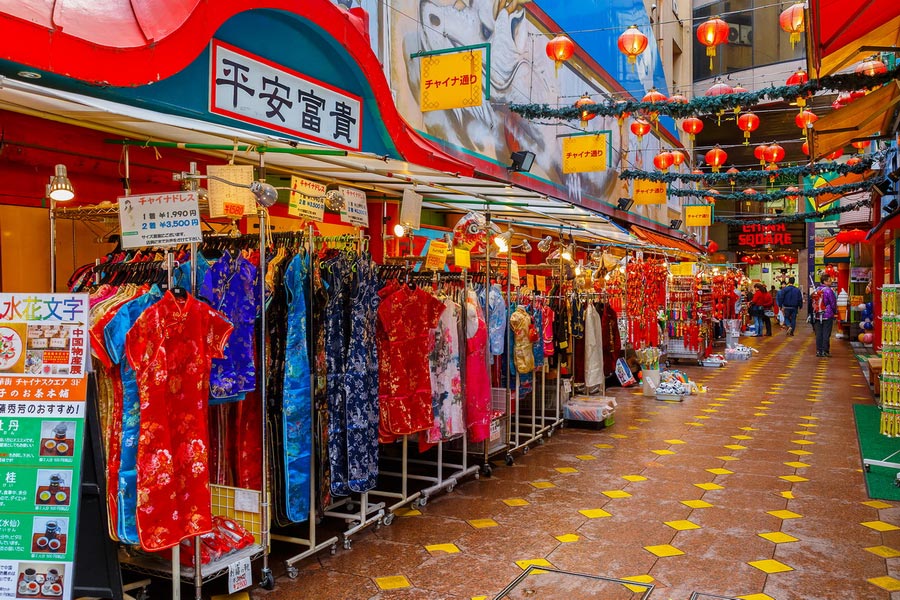
In 1859, Japan opened its borders, and many Chinese merchants came rushing into the port city of Yokohama. They revitalized trade and successfully established a vibrant commercial area. Even more, the Chinese immigrants recreated their own little Chinatown, with temples and streets decked out with colorful decorations. It became like a little piece of China in Japan.
Today, Chinatown's streets are chock-full of shops, from fancy boutiques to small shopping malls and souvenir shops. It's got a great food scene, with Chinese restaurants and eateries serving up all kinds of tasty dishes. Some of the local favorites include shark steaks, marbled beef, and a variety of different rice dishes. A visit to Chinatown promises a delightful shopping and dining experience for visitors.
Most goods at the market, like clothes, shoes, bags, jewelry, accessories, and souvenirs, are high-quality and fashionable. Plus, it's pretty rare to run into someone with the same items, so you can feel good knowing your purchases are unique and exclusive.
Red Brick Warehouse
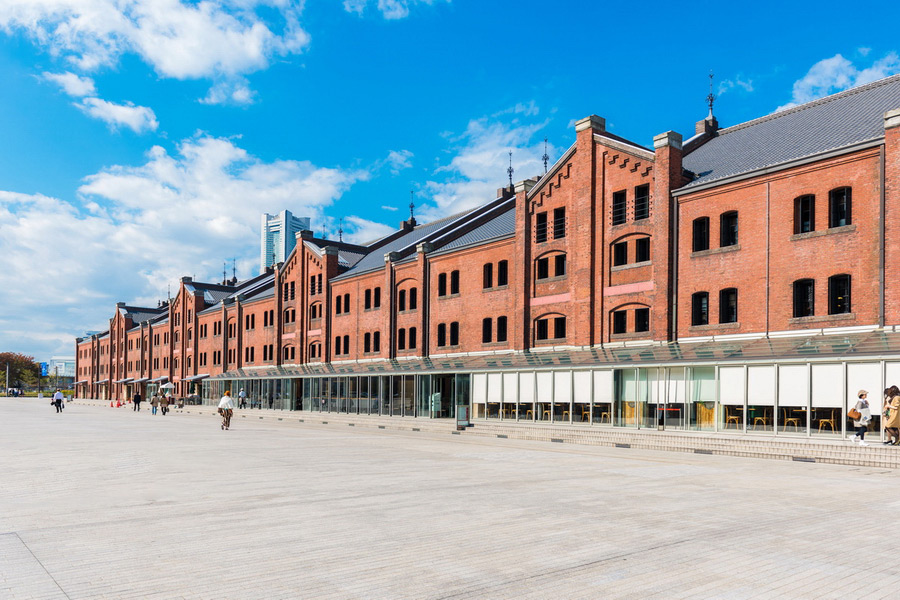
The Red Brick Warehouse is among the top shopping destinations in Minato Mirai, Yokohama. The 1911 building contains many small shops selling fashion, accessories, and trifles. It's an ideal spot for finding unique gifts and souvenirs. Whether you want clothing, arts, or crafts, the Yokohama Red Brick Warehouse has got your back.
Motomachi Street
When you are tired of the dazzling array of red and golden inscriptions of Chinatown, turn to a premier Motomachi shopping street. While it is mostly about renowned brands, fashion boutiques, and cozy cafes, its highlight is the opening view of the bay and the proximity to a nice green park. Motomachi is a vibrant and favorite area that attracts young and modern people who love fashion and chic trends.
Queen’s Square Yokohama
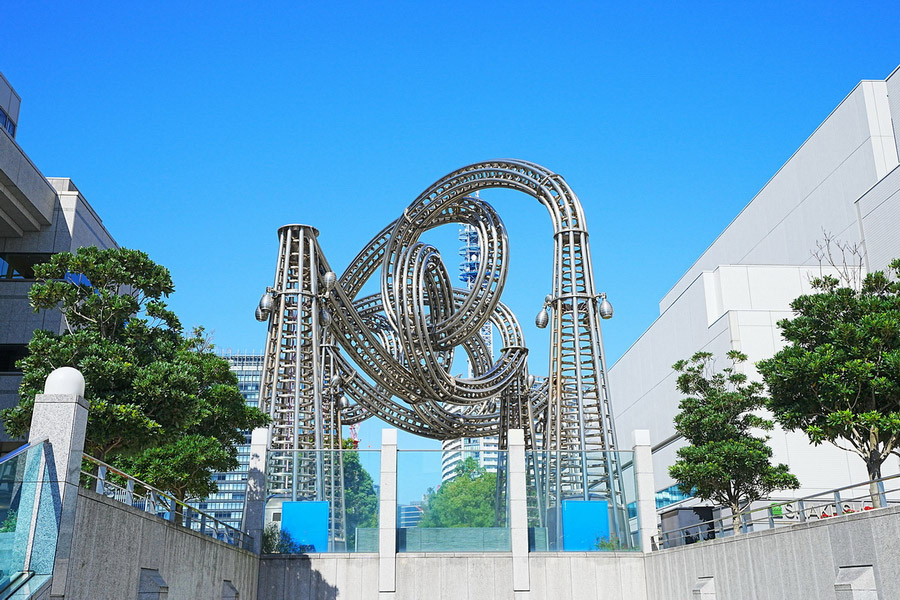
Even if you've shopped in Tokyo, Queen's Square Yokohama will impress you with its vast size. Get ready to navigate 7 floors of shops and restaurants. And before that, don’t forget to take a picture of an outdoor metal structure – Moku Moku Waku Waku.
World Porters
The sleek and contemporary shopping mall World Porters lies in the heart of Yokohama's trendy shopping district. Its slogan, "Something good, something elegant from all over the world," aptly describes the diverse collection of approximately 200 shops and restaurants housed within the complex. The top floor features the state-of-the-art Warner MYCAL cinema, comprising eight halls for movie enthusiasts.
Yokohama Bay Side Marina
Yokohama Bay Side Marina can be easily reached from the Landmark Tower. Located on Yokohama’s waterfront, it’s a great place for shopping, dining, and watching the sunset.
Lalaport Yokohama
Lalaport is another large shopping center in Yokohama that provides an extensive choice of mainstream fashion stores and international chains. It’s similar to many other shopping malls worldwide.
Food in Yokohama
Since Yokohama is home to Japan’s largest Chinatown, it offers a wide range of Chinese specialties. For breakfast, try Chinese porridge or enjoy Xiaolongbao for brunch—these small dumplings are so delicious you'll want to eat as many as you can. Char Siu is a flavorful addition to any meal. Kanagawa Prefecture's local dishes, Kenchin-jiru and Beef hotpot, are veggie-packed. And don't miss out on B-class delights Sanmamen and Iekei Ramen that originated in Yokohama. Get ready to try the best food in Yokohama.
Xiaolongbao
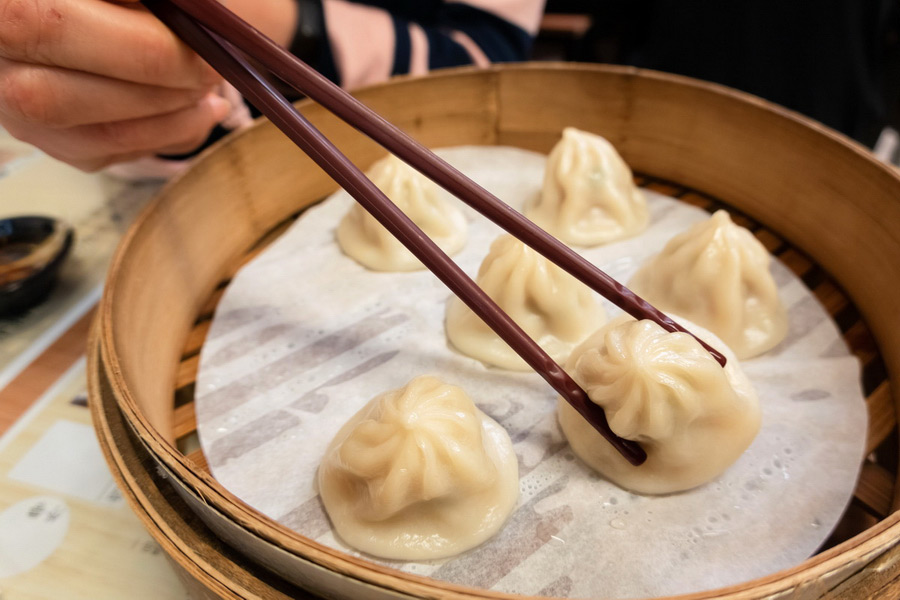
Xiaolongbao is one of the most praised Chinese dishes, known as dim sum, which means “touch the heart.” These dumplings are filled with ground pork and carefully wrapped. The chef skilfully folds each piece to give it a unique shape and steam afterward. When you break xiaolongbao with your chopsticks, a hot broth will spill out from inside. It’s delicious on its own but also pairs well with black vinegar and ginger. Additionally, Yokohama Chinatown offers grilled xiaolongbao and variations filled with shrimp, shark fin, or vegetables.
Sanmamen
Sanmamen is a ramen dish that evolved in Yokohama, deriving from the Chinese 'lamian.' It consists of thin, straight noodles with pork slices and stir-fried vegetables.
Kenchin-jiru Soup
Vegans will appreciate kenchin-jiru, a robust vegetable soup that originated from shojin ryori, the traditional Buddhist vegetarian cuisine. It typically includes tofu, root vegetables, and mushrooms, such as kombu and shiitake.
Chinese Rice Porridge
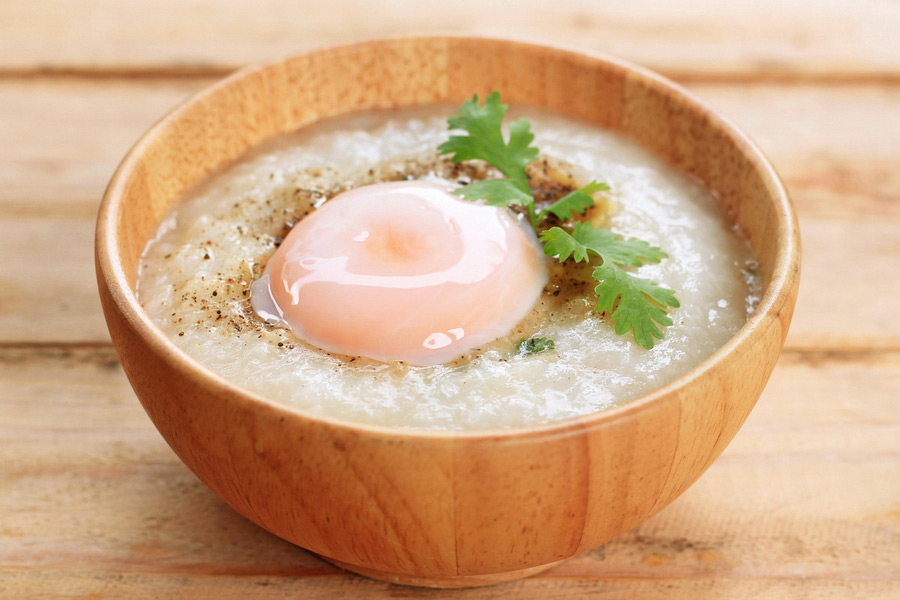
Unlike the simpler Japanese rice porridge okayu, the Chinese variant includes richer ingredients such as chicken, pork, or seafood and is often enhanced with coriander, pickles, and eggs.
Shumai
The Yokohama-style shumai is another type of Chinese-inspired dumplings. Traditionally a blend of pork and dried scallops, Chinatown dishes up crab as well as shrimp shumai. If you visit Yokohama during Ekiben Day on April 10, which celebrates bento lunch boxes, you will see the bento boxes sold at train stations around Yokohama. And shumai bento is a highlight in this port city. Dumplings remain tasty even after they cool off.
Iekei ramen
Iekei Ramen, known locally as Yokohama ramen, features a rich broth made from pork bones and soy sauce, served with thick noodles. “Iekei” translates to “house style”, and the dish is topped with a boiled egg and spinach, offering a hearty, flavorful meal.
Beef Hotpot
Following Japan’s opening in the 1850s, the demand for beef increased significantly. Many restaurants began serving gyu-nabe, a hotpot with simmered beef and vegetables, typically served in an iron pot with meat strips, veggies, and flat kishimen buckwheat noodles in a sweet and savory broth.
Mooncake
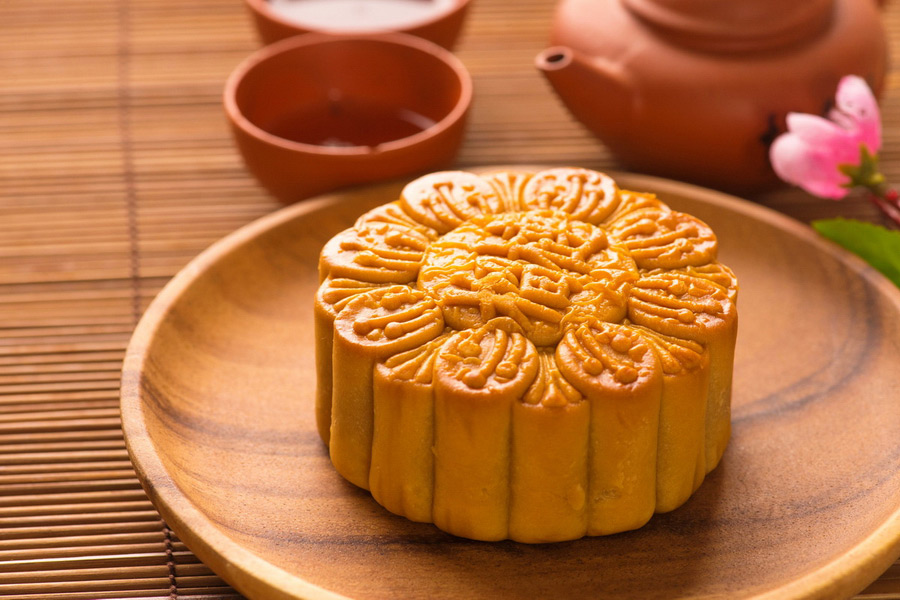
Mooncakes, a traditional pastry celebrated during China’s Mid-Autumn Festival, have found a home in Yokohama Chinatown. Made from wheat flour, sugar, lard, and water, the dough is filled with a sweet mixture of lotus seeds and red beans, then baked until golden.
Chashu
Chashu, a Japanese adaptation of Chinese barbecued pork (char siu), is a rich ramen topping consisting of tender slices of pork belly, served over noodles and meant to be savored with a dip into the flavorful broth.
How to Get to Yokohama
Traveling to Yokohama from Tokyo and other major Japanese cities is convenient due to multiple transport options including bullet trains and direct flights.
By Train:
JR Trains: Services from downtown Tokyo to Yokohama are plentiful, with JR and several private railway lines operating frequent trains. The journey typically takes under an hour, with Yokohama Station serving as the central hub and Shin-Yokohama Station located on the northern outskirts.
Shinkansen: The high-speed bullet train stops at Shin-Yokohama Station and is the fastest way to travel from central Tokyo, taking about 30 minutes. From Nagoya, the journey takes approximately 1 hour and 25 minutes, from Kyoto about 2 hours, and from Osaka about 3 hours and 40 minutes from Hiroshima.
By Air:
Keikyu Rail Line: This line provides a direct 30-minute connection between Haneda Airport and Yokohama Station. A shuttle bus service is also available.
Narita Express: The Narita Express offers a direct 90-minute train ride from Narita Airport to Yokohama Station. Route buses offering similar travel times are also an option.
Getting around Yokohama
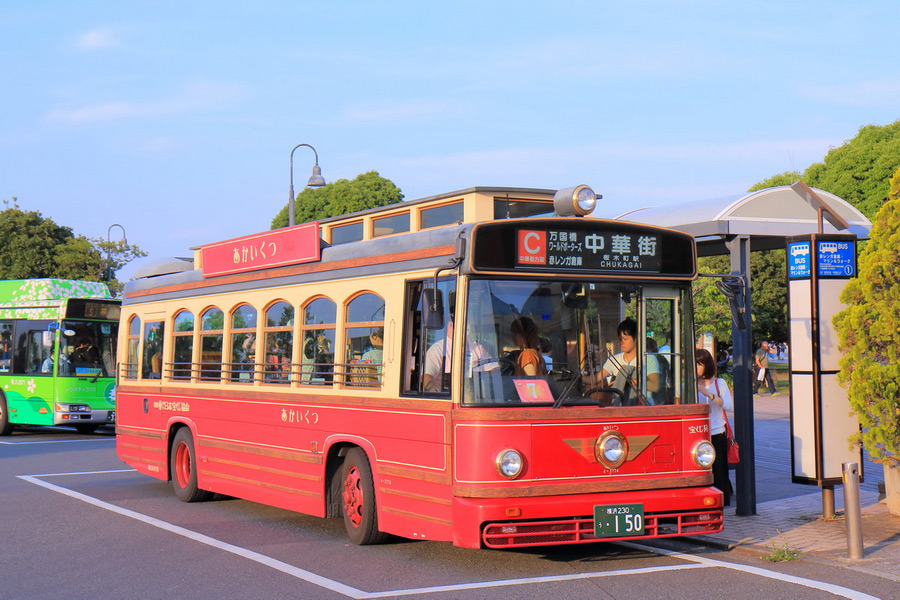
In Yokohama, you can travel around using four train companies, two subway lines, and buses run by the city and private companies.
You need to know about two major train stations - Yokohama Station in the city's heart, connected to all four railway companies, and the subway is very convenient. Shin-Yokohama Station, on the other hand, is outside the city center but a quick ten-minute train ride from Yokohama Station on either the JR Yokohama Line or the subway. It's also where the bullet shinkansen trains make their stop.
Yokohama is a walkable city, making it easy to explore many central streets and neighborhoods on foot. For instance, stretch your legs from Minato Mirai along the waterfront to Yamashita Park, stop by Osanbaishi Pier, and then shoot over to the nearby Yamate district or Chinatown from Yamashita Park.
If you're not into walking long distances, the Akaikutsu Loop Bus is a pleasant ride to get around central Yokohama. It takes you from Sakuragicho Station to all the major attractions. The Bayside Blue Bus is another option that hits up Yokohama Station, Minato Mirai, and other notable sights. Both buses run every 30-40 minutes, and a single ride is 220 yen. Or, you can grab a day pass for 500 yen and hop on and off as much as you want on these buses, other buses, and the subway in central Yokohama.
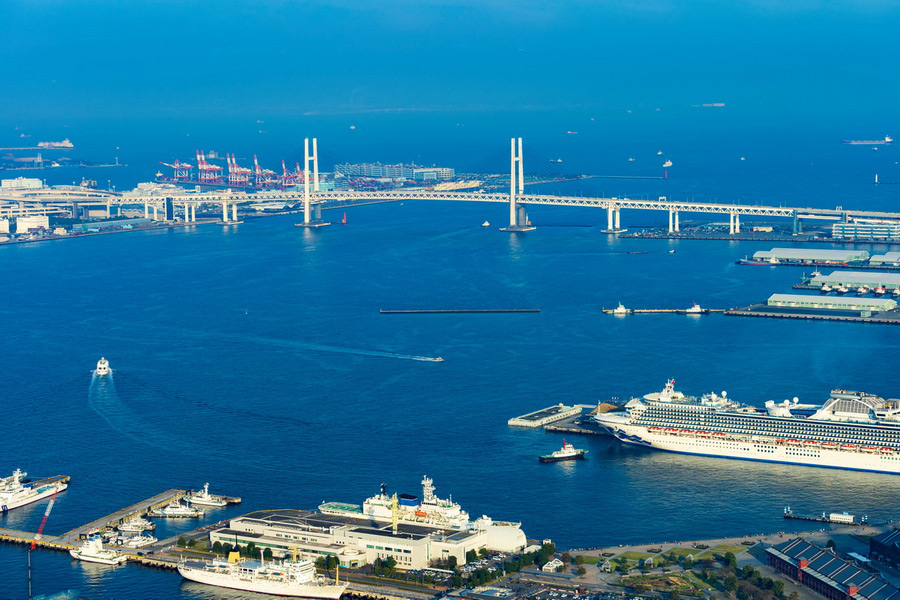
In addition, boat trips are possible too. The Yokohama Sea Bass provides services between Yokohama Bay Quarter from Yokohama Station east exit, Minato Mirai, and Yamashita Park leaves 2-3 times per hour.
When it comes to boats, they operate every 15-25 minutes only between Yokohama Bay and the Red Brick Warehouse, with some stopping at the Yokohama Hammerland complex.
On top of that, foreign visitors can easily travel with the Suica and Pasmo prepaid cards for almost all forms of public transport, including the Sea Bass.


